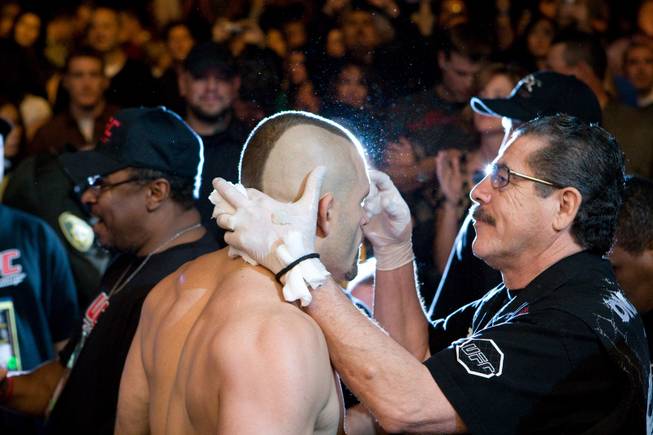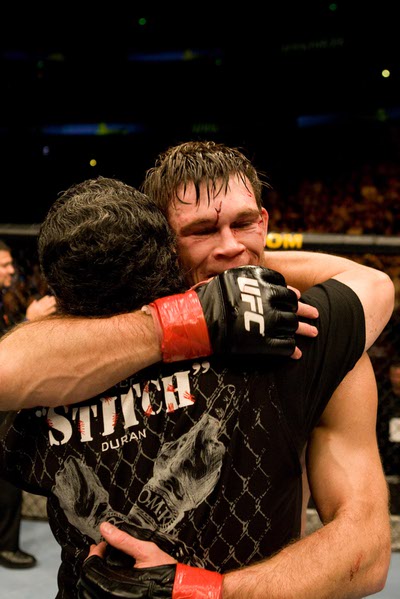
UFC
Jacob “Stitch” Duran, right, applies Vaseline to Chuck LIddell’s face before his bout with Wanderlei Silva at UFC 79 at Mandalay Bay in 2007.
Friday, July 3, 2009 | 8 a.m.
Punchy Points: UFC 100
- No. 1: Experts offer predictions
- No. 2: Top 5 significant fights in UFC history
- No. 3: Top 10 Fighters: The most influential men in UFC history
- No. 4: The Ring Girl: Logan Stanton breaks mold for UFC models
- No. 5: The Matchmaker: Silva avoids spotlight, aims it at fighters
- No. 6: The Ref: Dean relishes role, making right calls
- No. 7: Brave new world
- No. 8: The Cutman: Blood is Stitch’s trade and his bond
- No. 9: The Voice: Buffer offers unique entertainment to UFC events
- No. 10: A different brand of entertainment
UFC 100
- Complete UFC 100 coverage
- Brock Lesnar: Can anyone beat this man?
- St. Pierre dominant despite injury
- UFC co-owner addresses fans at Expo
- Love story leads to UFC
- Lesnar wins, puts on WWE-style show afterward
- Win or lose — Mir a class act
- 702.tv: All-In: UFC 100
- Punchy Points: Key aspects about UFC 100
- Interactive Timeline: UFC Countdown: 1 to 100
Editor's Note: The Ultimate Fighting Championship is celebrating its 100th show on July 11 at the Mandalay Bay Events Center. In the days leading up to this historic night, the Las Vegas Sun is presenting a Top 10 list of key personalities and points that have helped propel the sport into the forefront of the world's fighting conscience.
When you bathe your hands in blood enough times, few situations tend to disturb you.
While that sentence may sound like the M.O. for a serial killer, it’s actually a day-to-day motto for UFC cutman Jacob “Stitch” Duran.
In his more than 14 years of tending to the mugs of boxers and mixed martial artists since moving to Las Vegas, there have only been two situations that have made the legendary cutman queasy.
“Jonathan Goulet kneed Jay Hieron right between the eyes (during their bout at Ultimate Fight Night 2 at the Hard Rock in 2005). He popped that big vein there. The cut wasn’t that big, but he severed the artery causing blood to just pump out. It poured out and poured out,” said Duran, who admitted the situation was the only time in his career he ever felt nauseated.
“In between rounds I’m working on him, cleaning Jay up and applying pressure on the cut. I knew I was in trouble when I applied the final solution of Vaseline and Adrenaline Chloride 1:1000 (used to constrict blood vessels) and the blood gushed right through the Vaseline. They continued fighting, but by the time it was over both fighters had blood from the top of their heads to their bottom of their feet. That was the bloodiest one ever.”
The second uneasy moment was much less bloody, but far more scary when Stitch had to quickly help Corey Hill after he sustained a horrific leg fracture during his bout against Dale Hartt at UFC: Fight for the Troops last December.
“I’m holding Corey by the shoulder and he’s asking me ‘Stitch what happened?’ And I’m trying to comfort him but also tell him that he just broke his leg badly. I’m telling him to go ahead and scream as loud as he wants because it was an ugly, ugly situation. Finally I had to just look away because his leg was freaking me out so bad.”
But before you start to think Stitch’s duties are all gore and gloom, there’s a lot more to Duran’s “dream job” than just the cuts.
“There’s a real bond you develop with the fighters when you share such trauma-filled situations,” said the 57-year-old Planada, Calif. native, who after joining the Air Force was stationed in Thailand. There he studied Muay Thai.
Duran went back to California and was so enamored with the sport that he decided to open up his own kickboxing gym in Fairfield in the mid 1980s.
He quickly adapted to all aspects of the fight game, training, management, running the gym, etc. But true to his own nickname, Stitch’s knack always came back to stopping blood in its tracks.
“I don’t know, I guess I had a little success a couple of times and just enjoyed the challenge of it. Knowing that I was helping fighters continue with the fight that they’ve put so much hard work to prepare for,” said Duran, who in 1995 packed up his family and headed to the fight capital of the world.
He worked his first title fight when Julio Cesar Chavez defeated Tony “The Tiger” Lopez in Monterrey, Mexico in 1994. But it was three years later at the Thomas & Mack Center during the Raul Marquez and Keith Mullings IBF light middleweight title fight where Stitch made magic.
“Afterwards Marquez needed about 75 stitches to close five major cuts, but I kept him in the fight and he won,” Duran said with a laugh. “From there a lot of fighters wanted to work with me.”
So too did a former boxing buddy turned MMA promoter, Dana White.
“I remember running into Dana at a K1 kickboxing event at the Bellagio. He was telling me how the Fertittas (UFC owners Frank and Lorenzo) had just purchased the UFC and they wanted some professional cutmen to take care of the fighters. Obviously it didn’t take me very long to make my mind up, and I’ve been living this dream ever since,” said Duran, who in addition to his cutman duties also wraps fighter's hands before their bouts.
Stitch — who says MMA cuts are a lot trickier to deal with than boxing cuts “because the cuts are often multiple lacerations often on top of the head or in places where boxers would never get them — says unlike his introduction to the science of stopping blood where he patched everything together through his own trial and error, he wants to share his knowledge to future cutmen.
That’s why Duran developed an instructional video, “Giving The Fighter One More Round” to help others learn the art of 60-second surgeries.
But aspiring corner artists don’t need to watch Duran’s video, or read any of the stories in the soon-to-be-released “The Jacob Stitch Duran” book to learn of the cutman’s most important lesson on how to stomach all the eyesores inside the Octagon or ring.
“I always tell myself ‘It’s not my cut, it’s not me who’s bleeding,’” Stitch said. “I mean I’ve seen some nasty cuts, literally ones down to the bone. But mentally it’s easy to remember that I’m only a guy who is facilitating these great warriors in their battle. Plus after that first cut of the night the adrenaline is already kicking in.”


Join the Discussion:
Check this out for a full explanation of our conversion to the LiveFyre commenting system and instructions on how to sign up for an account.
Full comments policy